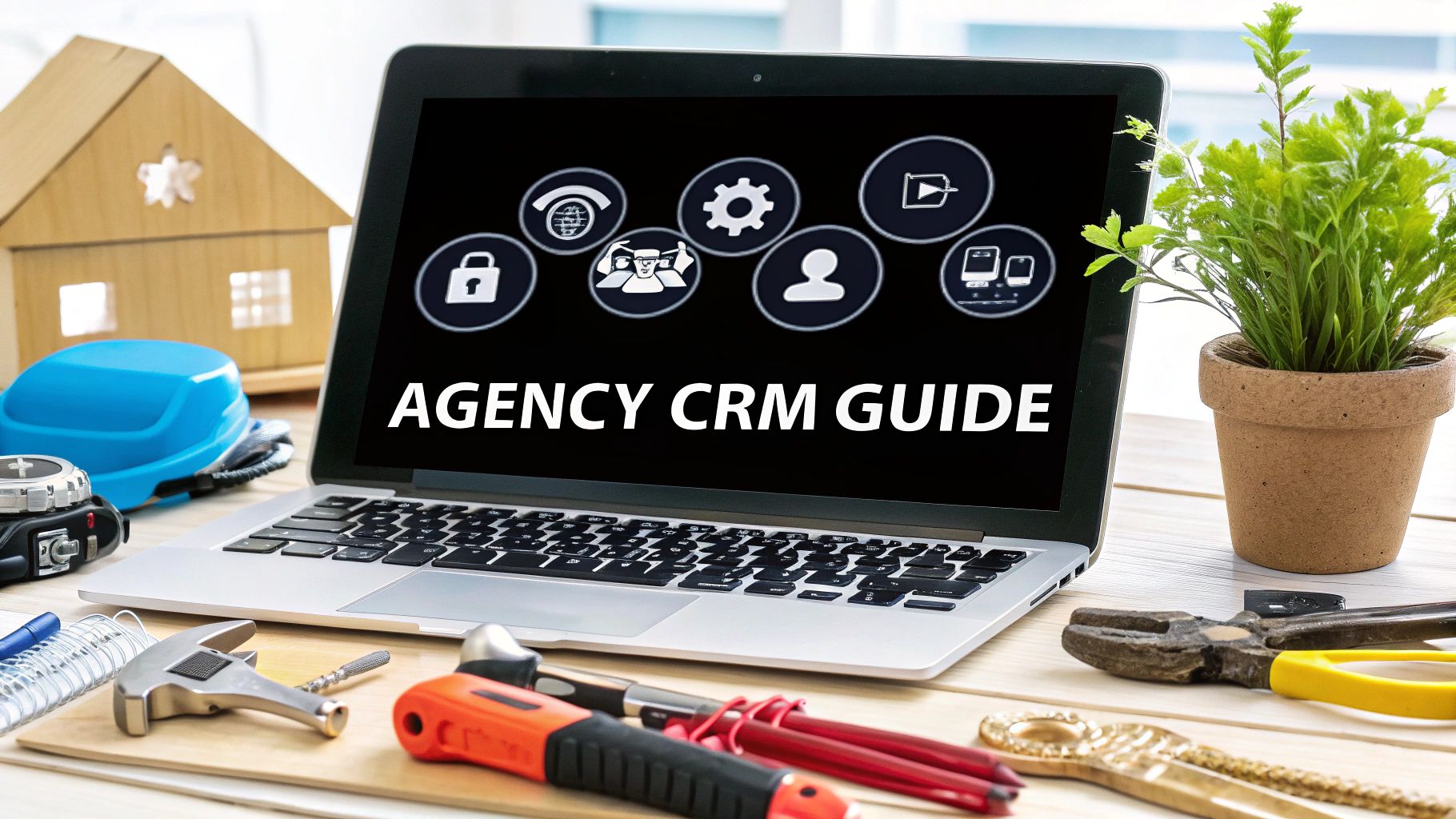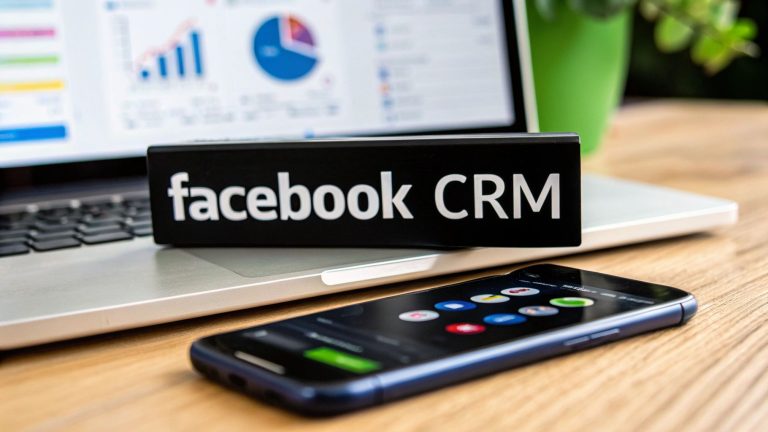A Guide to CRM for Agency Growth
Think of a standard CRM as a basic wrench. It’s a great tool for one specific job, but try to build an entire engine with it, and you'll quickly get frustrated. Now, a CRM built for agency life? That’s the whole mechanic's toolkit, designed from the ground up to handle the messy, wonderful chaos of managing clients, projects, and creative teams all at once.
Why Your Agency Needs More Than a Standard CRM
Most CRMs you'll find off the shelf are built with one thing in mind: a straight-line sales process. They’re fantastic at moving a lead from "potential" to "closed deal." But that’s not how agencies work, is it? Our world is a cycle of proposals, onboarding, project execution, client feedback loops, reporting, and invoicing—often for dozens of clients at the same time.
Trying to shoehorn that complex reality into a generic CRM is a recipe for friction. It’s where so many of the classic agency growing pains come from:
- Scattered Information: Client emails live in one place, project tasks in another, and the financial details are stuck in a spreadsheet nobody can find. Sound familiar?
- Zero Visibility: It’s almost impossible to get a quick, clean answer to questions like, "Is this project actually profitable?" or "What's my team's real workload this week?"
- Painful Manual Reporting: Your team wastes hours that could be spent on creative work just pulling data from five different sources to build a simple client report.
This is the exact problem a purpose-built system solves. It turns a scattered mess of tools into a single, organized command center.
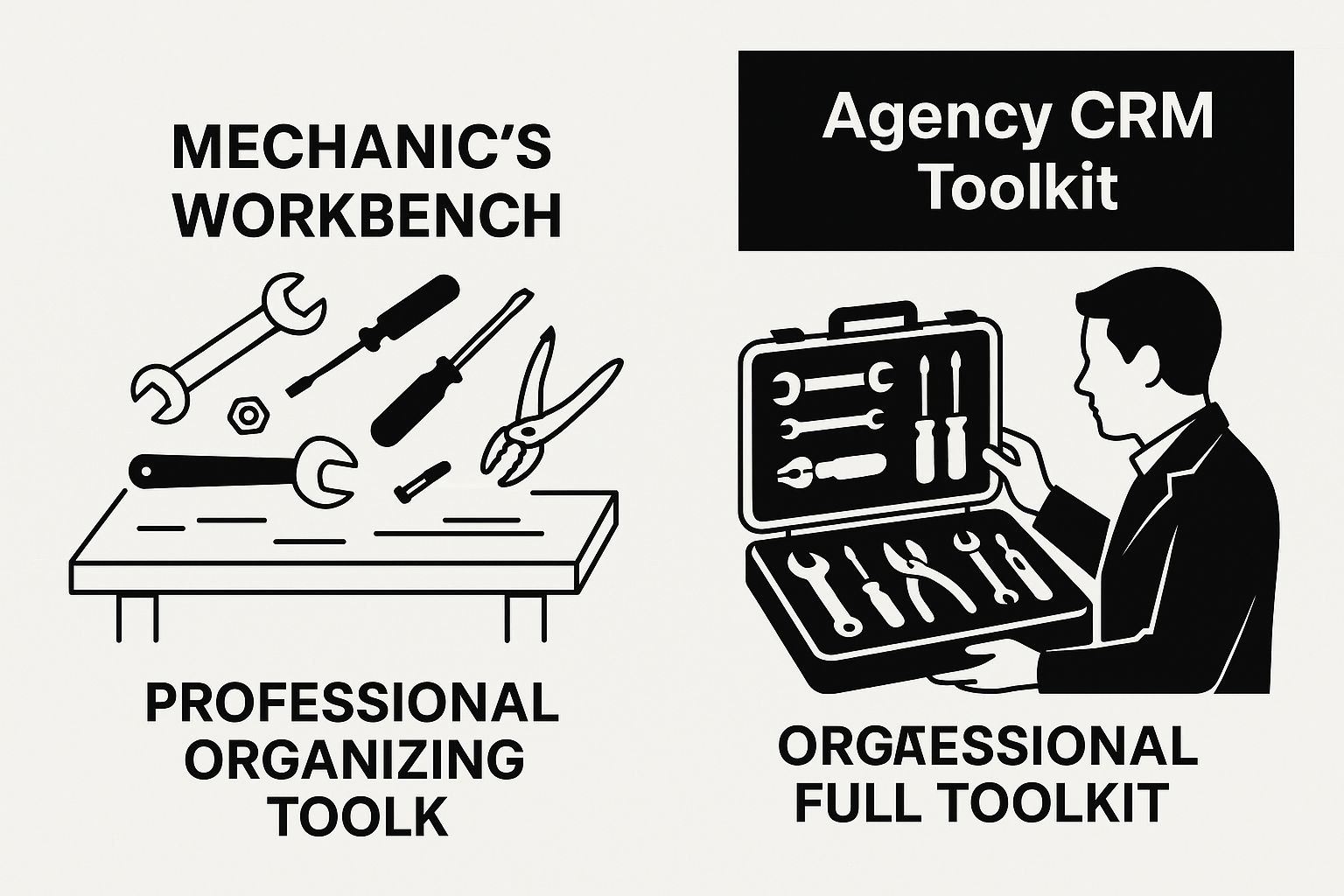
As you can see, a specialized CRM doesn't just store information; it connects it, bringing order to what can often feel like total chaos.
An agency-specific CRM isn't just a database of contacts. It's the operational hub that connects your people, your projects, and your profits into a single source of truth.
The explosive growth of the CRM market shows just how essential these platforms have become. Between 2010 and 2020, annual CRM software revenue shot up from $14 billion to $69 billion—a massive 393% jump. This isn't just about sales teams anymore; it's about businesses like agencies needing a central nervous system to run their entire operation. You can discover more insights about CRM market growth on flowlu.com.
Essential Features of a True Agency CRM
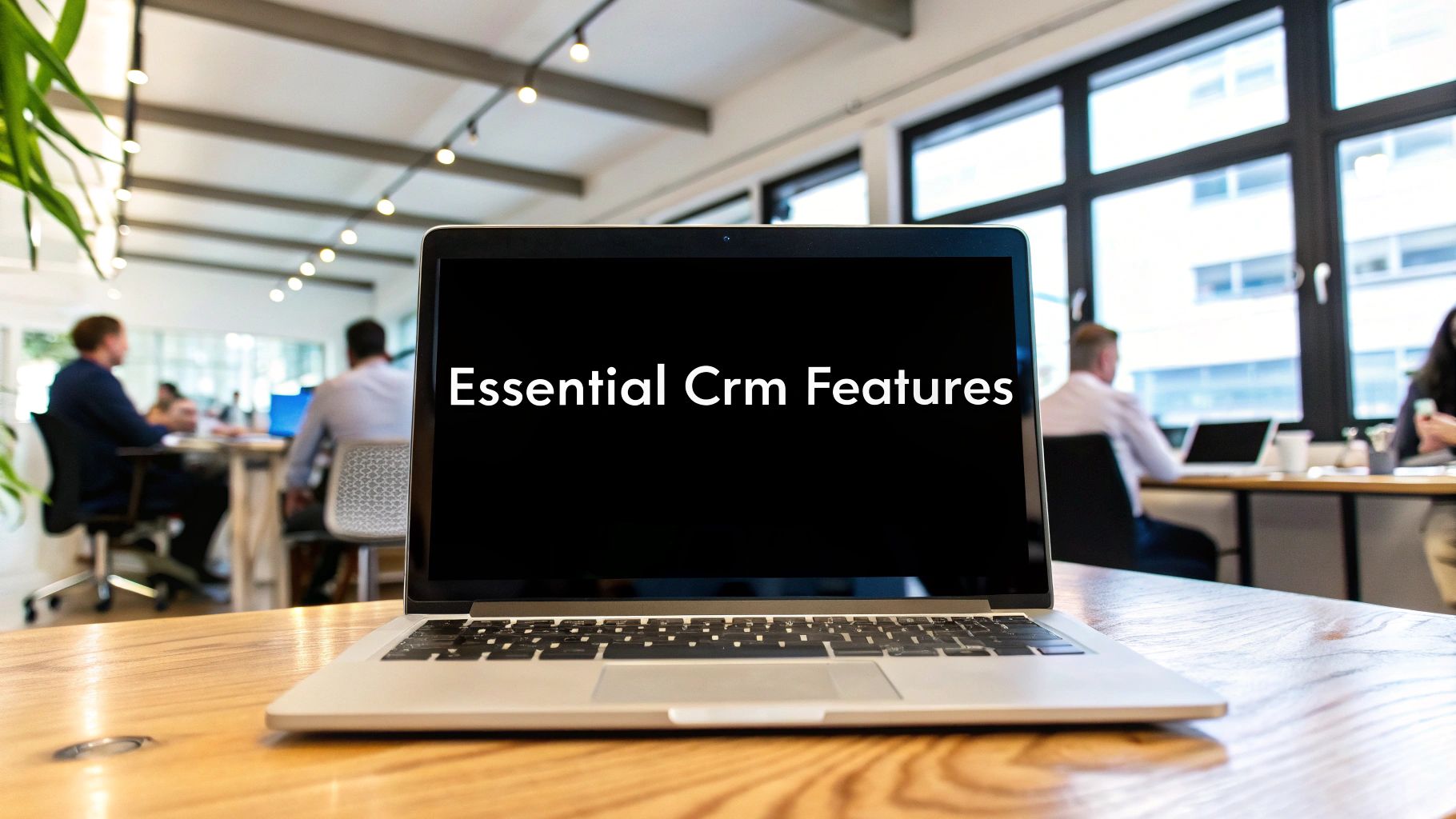
Let’s be honest, a simple contact list just doesn't cut it for a modern agency. A real agency CRM is much more than that. It’s the central nervous system of your operations, a unified platform where every feature is built to solve the unique headaches that agencies face every single day.
The biggest difference between a generic CRM and one built for us? Connection. Instead of juggling separate apps for project management, time tracking, and client emails, a true agency CRM brings it all together. A task isn't just a to-do item on a list; it's directly tied to a client account, a specific project, and the hours your team has logged against it.
Integrated Project and Task Management
The absolute must-have feature of a CRM for agency life is its ability to blend client data with project execution. It’s the difference between knowing who your client is and knowing what your team is doing for them right this second.
This seamless integration gives you the full story. You can manage deadlines, assign tasks to your team, and track progress, all while seeing the client’s entire communication history. No more flipping between your project management tool and your contact list. That alone saves an incredible amount of time and prevents things from falling through the cracks.
Key capabilities you should look for include:
- Centralized Task Boards: Get a bird's-eye view of all client workflows in one spot.
- Project Templates: Instantly create new projects with pre-built tasks and timelines for your most common services.
- Direct File Sharing: Attach creative assets, briefs, and client feedback right where they belong—on the project itself.
Profitability and Resource Tools
Which of your clients are actually making you money, and which are secretly draining your team’s time? A proper agency CRM answers this with hard data, not just a gut feeling. At its core is precise time tracking, allowing your team to log their hours against specific tasks and projects.
When you connect that time data to project budgets and client retainers, you get a crystal-clear view of profitability. You can spot scope creep the moment it starts and see exactly where your team’s energy is going.
A purpose-built CRM doesn’t just manage relationships; it manages profitability. It turns abstract concepts like team capacity and project health into clear, actionable metrics that drive better business decisions.
On top of that, resource management tools give you a high-level look at everyone's workload, helping you distribute tasks evenly and avoid burnout. And let's not forget automation. By automating routine administrative work like generating client reports, you free up more of your team’s time for billable work. If you're new to this idea, our guide explains more about what is workflow automation.
To make the distinction clearer, here's a quick breakdown of how a standard CRM stacks up against a purpose-built agency CRM.
Standard CRM vs Agency CRM Feature Comparison
| Feature Area | Standard CRM Capability | Agency CRM Capability |
|---|---|---|
| Core Focus | Sales pipeline management and lead tracking. | Client lifecycle management from proposal to project delivery and reporting. |
| Project Management | None, or requires a third-party integration. | Natively integrated project boards, tasks, templates, and timelines. |
| Time Tracking | Basic or non-existent. | Granular time tracking against clients, projects, and specific tasks. |
| Profitability | Tracks deal value and sales revenue. | Calculates real-time project and client profitability based on budgets and hours. |
| Client Communication | Logs emails and calls for sales context. | Centralizes all client communication, files, and feedback within the project workspace. |
| Resource Planning | Focuses on sales rep performance. | Manages team capacity, allocates workloads, and prevents overallocation. |
As you can see, while a standard CRM is great for a typical sales team, an agency's needs are far more complex. Choosing a platform designed for your workflow isn't a luxury—it's essential for scaling profitably.
How Your CRM Drives Agency Profitability
Let's get one thing straight: an agency-focused CRM isn't just another tool to keep you organized. It's a direct pipeline to a healthier bottom line. It takes those vague "gut feelings" about how a project is going and turns them into cold, hard data you can actually use.
This is the big shift. It's what separates the agencies that constantly feel like they're scrambling from the ones that scale smoothly and predictably. You move from guesswork to data-backed decisions.
The first thing you'll notice is where all the money is leaking out. With solid time tracking and budget management built right in, you finally get a clear picture of where your team's hours are going. This is how you spot scope creep the second it starts, letting you have a real conversation with the client instead of just eating the costs.
Find Out Who Your Best (and Worst) Clients Really Are
Think of a good CRM for agency operations as an X-ray for your client list. It automatically connects billable hours and project costs to each client, calculating profitability on the fly. No more guessing.
Suddenly, you see who your true growth partners are and which clients are quietly bleeding you dry with "just one more tweak" and endless out-of-scope demands.
Once you have this clarity, you can make some powerful moves:
- Pour fuel on the fire: Double down on your most profitable accounts. Find new ways to deliver massive value to the clients who already love you.
- Fix the broken ones: Go back to unprofitable clients with data in hand. It’s time to renegotiate that retainer or adjust the scope to bring the relationship back into the black.
- Sharpen your aim: Use the data from your best clients to build a laser-focused profile of who you should be targeting next. Attract more winners.
Get Your Billable Hours Back with Automation
Every minute your team spends manually building an invoice, pulling together a status report, or updating a spreadsheet is a minute they aren't doing valuable, billable work. It's that simple.
A CRM hands all that tedious admin work over to the machines. This frees up your most important asset—your team's brainpower. That reclaimed time goes straight back into client work, boosting your capacity and your revenue.
The real ROI of a CRM isn't just in the new business it helps you track. It's in the billable hours it gives back to your team, letting them focus on the creative, strategic work clients happily pay for.
Finally, having a single, unified view of every touchpoint with a client—from the first email to the final invoice—massively elevates your quality of service. And better service means better client retention, which is the bedrock of long-term growth. It’s not just about working faster; it’s about building a more resilient, more profitable agency from the inside out.
How to Choose the Right CRM for Your Agency
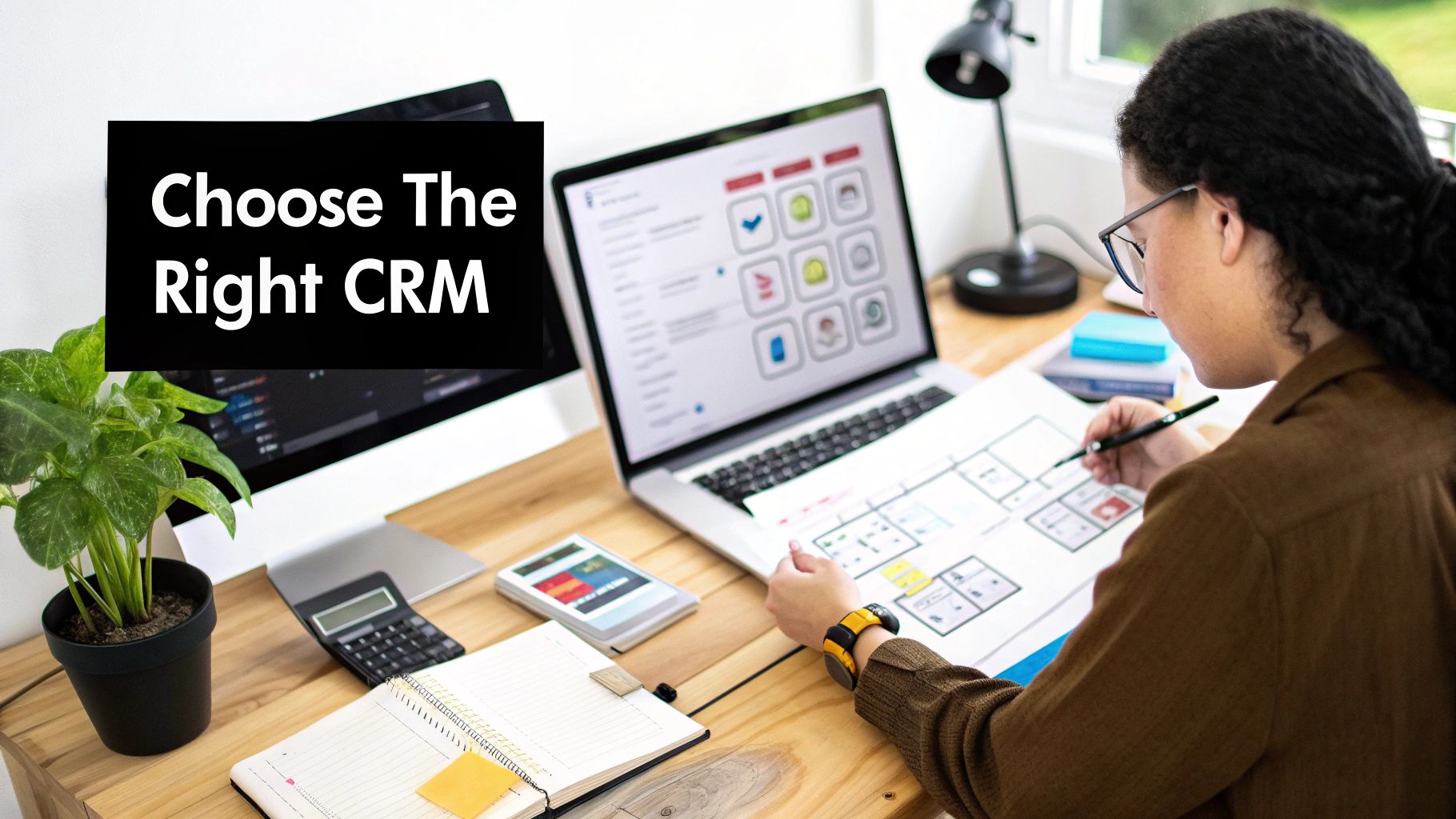
Picking the right CRM for your agency can feel like a huge task. With so many platforms promising to solve all your problems, it’s easy to get lost. But here’s the secret: the best CRM isn't the one with the most features. It's the one with the right features that fix your agency's unique headaches.
So, don't start by looking at software demos. Start by looking inward at your own operations.
Map out your entire workflow, from that first client discovery call all the way to sending the final invoice. Where do things get stuck? Pinpoint exactly where communication falls apart, tasks slip through the cracks, or reporting becomes a manual, time-sucking nightmare. This internal audit is your roadmap—it tells you exactly what problems your new CRM needs to solve.
Create Your Must-Have Feature Checklist
Once you know your bottlenecks, you can build a smart, prioritized feature checklist. This isn’t a wishlist of every cool bell and whistle you’ve ever seen. It’s a targeted list of your non-negotiables.
Different agencies have different needs. A creative shop might put client portals for asset approval at the top of their list, while a PR firm would prioritize a rock-solid system for managing media contacts.
Organize your list into three simple tiers:
- Must-Haves: These are the absolute deal-breakers. Think integrated project management, time tracking, or whatever functions your agency simply can't run without.
- Should-Haves: These features would bring massive improvements but aren't strictly essential to get the job done. This could be something like advanced reporting dashboards or automated client onboarding.
- Nice-to-Haves: These are the cool extras that would be great but aren't critical for your immediate needs—things like AI-powered sales forecasting.
This approach keeps you focused and prevents you from getting distracted by flashy features you'll never actually use. For a deeper dive into tools built for marketers, check out our guide on the best CRM for marketing agencies.
Look Beyond the Features
Finally, you have to think about the practical stuff that ensures your team actually adopts the tool. A powerful CRM for agency growth is completely useless if it doesn't fit into your existing world.
The best CRM is not the one with the most impressive demo. It's the one your team will actually use every single day because it makes their jobs easier, not harder.
Before you pull the trigger, make sure you get clear answers to these critical questions:
- Integrations: Does it play nice with the tools you already rely on? We're talking about your accounting software, email marketing platform, and file storage. A seamless connection is non-negotiable.
- Scalability: Will this platform grow with you, or will you outgrow it in a year? Look at the per-user pricing and ask if it can handle more clients, bigger projects, and a larger team down the road.
- Support: What happens when something goes wrong? Good customer support can be the difference between a five-minute hiccup and a full-blown operational crisis. You need a team that has your back.
A Realistic Plan for CRM Implementation
Let's be real: even the most powerful CRM for agency life is doomed to collect dust if your team doesn’t actually use it. The biggest challenge with any new software isn’t the tech—it’s the people. Success hinges on a smart rollout that makes the CRM feel like an essential part of the day, not just another password to forget.
A great way to kick things off is by picking an internal CRM champion. This isn't always a manager; it’s often a well-respected team member who's genuinely excited about what the new system can do. They'll become the go-to person for questions, share wins, and build some positive buzz from the inside.
Start Small and Build Momentum
Forget the big, disruptive, agency-wide launch. A phased rollout works so much better. Start with a single team or one specific workflow, like managing your new business pipeline. This gives you a safe space to iron out any wrinkles and score some early wins you can show off to everyone else.
Data migration is another huge step. Pulling all your information from old systems and spreadsheets can feel like a slog. If your agency is still running on spreadsheets, it’s worth thinking about just how much a real system can improve things. You can dive deeper in our guide on moving from Google Sheets to a CRM.
A successful CRM rollout isn't a one-and-done event. It’s all about consistent, ongoing support and training. The real goal is to weave the tool into your agency's daily rhythm until using it feels totally natural.
This focused approach is the secret to beating the adoption slump. While the average CRM adoption rate can be as low as 26%, the data shows that top-performing agencies are 81% more likely to use their CRM consistently. By keeping the process manageable and proving its value early on, you set your team up to win and make sure your investment actually pays for itself. You can read the full research about CRM usage on sltcreative.com.
The Future of AI in Agency CRM Platforms
The next big shift in agency CRMs isn't some far-off concept—it's already here, and it's all about AI. These platforms are quickly moving beyond being simple digital filing cabinets. They're becoming active, intelligent partners that can actually anticipate what you need and automate decisions that used to eat up your day.
This isn't about robots taking over the creative work. It’s about giving your team a serious upgrade with data-driven smarts.
Think about a CRM for agency work that does more than just hold contact info. Picture a system that flags a client as a churn risk because it noticed a drop-off in email response times. Or one that suggests the perfect designer for a new project by looking at their current workload and how they knocked a similar job out of the park last quarter. That’s AI in action, right now.
Smarter Operations and Predictive Insights
Generative AI is also starting to pull its weight. It can draft the first version of a project brief, whip up a quick summary for a status update, or even generate a solid starting point for a proposal.
By digging into your past project data, machine learning can now predict more accurate timelines and quotes. This helps protect your profit margins before you even kick off the work. This move toward predictive insights isn't just a cool feature; it’s becoming the new standard for staying competitive.
The real magic of AI in an agency CRM is its knack for answering questions you haven’t even thought of yet. It turns your old data into a clear roadmap for what to do next.
The numbers don't lie. By 2024, a whopping 65% of businesses—agencies included—had already started using CRMs with generative AI features. And it pays off: agencies using these tools are 83% more likely to crush their sales targets.
It’s no surprise that AI features have become the #1 trend in the CRM world, with 51% of businesses prioritizing them to sharpen their operations and client service. You can dig into more of these CRM trends and stats on crm.org. This whole evolution is arming agencies with tools for a level of precision we've never seen before.
Ready to stop wasting time on manual lead management and start responding faster? LeadSavvy Pro instantly syncs your Facebook leads to a Google Sheet or our integrated CRM, so you can focus on what matters—growing your agency. Get started for free today at https://leadsavvy.pro.

